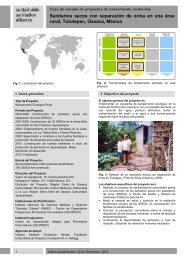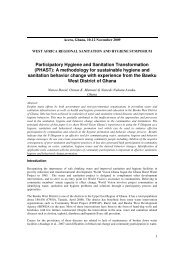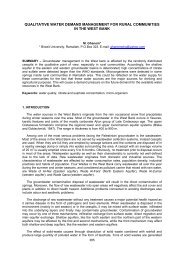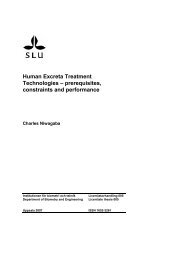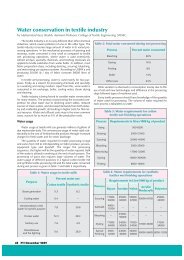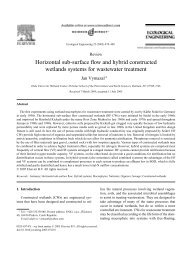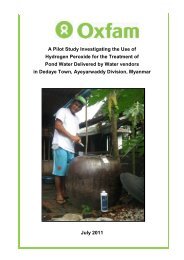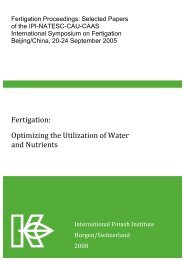Experiences with urine diverting dry toilets - EcoSan Club
Experiences with urine diverting dry toilets - EcoSan Club
Experiences with urine diverting dry toilets - EcoSan Club
You also want an ePaper? Increase the reach of your titles
YUMPU automatically turns print PDFs into web optimized ePapers that Google loves.
Innovative <strong>urine</strong> <strong>diverting</strong> <strong>dry</strong> toilet (UDDT)<br />
designs from East Africa<br />
This paper presents different UDDT designs from East Africa, which are responding<br />
to their users´ preferences and needs.<br />
Abstract<br />
Key Messages:<br />
Sustainable Sanitation Practice<br />
10<br />
<br />
<br />
<br />
<br />
Author: Elke Müllegger<br />
Toilets are commonly not viewed as being attractive or interesting. They are normally designed only to serve a certain<br />
purpose - a function called excreta management, which is already unattractive by itself. In combination <strong>with</strong> the need to<br />
develop low-cost solutions, design is often neglected. In East-Africa <strong>urine</strong> <strong>diverting</strong> <strong>dry</strong> <strong>toilets</strong> (UDDTs) are constructed<br />
since almost 15 years. But still most of the UDDTs have a similar design <strong>with</strong> very view adaptations. The paper presents<br />
different designs of UDDTs which are based on experiences from more than 10 years of sanitation system planning in the<br />
region.<br />
Introduction<br />
Planning in sanitation was and still lies mainly in the hands<br />
of technicians. Solid and liquid waste management,<br />
treatment and disposal are solved purely on a technical<br />
basis, neglecting the fact that sanitation is more than<br />
just a technical problem (Müllegger and Lechner, 2005).<br />
However, during the last years sanitation marketing has<br />
become a keyword which captures the sanitation sector.<br />
The WSP Field Note “The case for marketing sanitation”<br />
even states that “development of the sanitation market<br />
is the only sustainable approach to meeting the need for<br />
sanitation in the developing world. […] Marketing has<br />
been more successful than anything else in changing the<br />
behaviour of people when they can see direct personal<br />
benefits.” (WSP, 2004) Choosing a (social) marketing<br />
approach means that the attractiveness of the product<br />
is one important factor among others. Consequently<br />
toilet designs must respond to what people want, rather<br />
than what sanitary engineers believe they should have<br />
(WSP, 2004). A range of different products are needed to<br />
suit a variety of pockets and circumstances. Hence it is<br />
important to keep <strong>toilets</strong> affordable and that the market<br />
offers a range of products <strong>with</strong> various price tags.<br />
Garduños (2005) gained experiences how important<br />
design and affordability is in Mexico and assumed that<br />
“it seems that the paradigm is changing, as owning a WC<br />
Choosing a (social) marketing approach shows that attractiveness of the product and the appropriate price is the key.<br />
Consequently:<br />
• toilet design must respond to what people want,<br />
• toilet design has to be attractive, and<br />
• <strong>toilets</strong> have to be affordable.<br />
is no longer a status symbol. The reference point now is<br />
simply a dignified and efficient sanitation system, and<br />
the <strong>dry</strong> <strong>toilets</strong> seem to fully satisfy those expectations.”<br />
Based on that, Garduño has developed a variety of<br />
innovative sanitation solutions, which are architecturally<br />
designed and developed <strong>with</strong> community involvement.<br />
The following examples are all based (1) on a constant<br />
adaptation of toilet designs over the last 10 years and (2)<br />
on a participatory planning approach, meaning that the<br />
users were included in system development right from<br />
the beginning and they decided how the particular toilet<br />
shall look like.<br />
1. UDDTs <strong>with</strong> underground chambers: Most UDDTs<br />
are constructed above the ground <strong>with</strong> steep stairs<br />
to enter the toilet. Where soil conditions allow,<br />
the substructure can also be constructed into the<br />
ground, providing a comfortable design especially<br />
for handicapped or elderly. Kitgum Town Council in<br />
Uganda decided to construct a barrier free toilet for<br />
their staff.<br />
2. Indoor UDDTs: Flush <strong>toilets</strong> are commonly the only<br />
sanitation facilities which are constructed indoor. Two<br />
examples from Uganda show that UDDTs can also be<br />
integrated into a house, aiming to increase the users´<br />
comfort.<br />
Issue 6/2011



